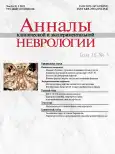Clinical features of stroke in the artery of Percheron territory (case series)
- Authors: Annushkin V.A.1, Nikonov A.A.1, Maksimova M.Y.1, Lagoda О.V.1, Tanashyan M.M.1
-
Affiliations:
- Research Center of Neurology
- Issue: Vol 16, No 3 (2022)
- Pages: 92-98
- Section: Clinical analysis
- URL: https://journals.rcsi.science/2075-5473/article/view/124072
- DOI: https://doi.org/10.54101/ACEN.2022.3.11
- ID: 124072
Cite item
Full Text
Abstract
The article describes two clinical cases of stroke in the artery of Percheron territory. The difficulty in recognizing the causes of ischaemic stroke in these patients was due to the polymorphism in the mental disorders and the rare "strategic infarct dementia", as well as impaired consciousness. We hereby present the clinical features of this condition, which can be used together with neuroimaging methods (including various MRI sequences) to ensure a timely and accurate diagnosis.
The authors describe a clinical case to demonstrate their approach to the diagnosis and management of this patient group.
Full Text
##article.viewOnOriginalSite##About the authors
Vladislav A. Annushkin
Research Center of Neurology
Author for correspondence.
Email: annushkin-v@mail.ru
ORCID iD: 0000-0002-9120-2550
aduate student, 1st Neurological department, Institute of Clinical and Preventive Neurology
Russian Federation, MoscowAlexey A. Nikonov
Research Center of Neurology
Email: nikonoffff@mail.ru
ORCID iD: 0000-0003-4934-1423
Cand. Sci. (Med.), neurologist, 2nd Neurological department, Institute of Clinical and Preventive Neurology
Russian Federation, MoscowMarina Yu. Maksimova
Research Center of Neurology
Email: ncnmaximova@mail.ru
ORCID iD: 0000-0002-7682-6672
D. Sci. (Med.), Professor, Head, 2nd Neurology department, Institute of Clinical and Preventive Neurology
Russian Federation, MoscowОlga V. Lagoda
Research Center of Neurology
Email: angionev@gmail.com
ORCID iD: 0000-0001-7562-4991
Cand. Sci. (Med.), senior researcher, 1st Neurological department, Institute of Clinical and Preventive Neurology
Russian Federation, MoscowMarine M. Tanashyan
Research Center of Neurology
Email: M_Tanashyan2004@mail.ru
ORCID iD: 0000-0002-5883-8119
D. Sci. (Med.), Professor, Corresponding member of RAS, Deputy Director for science, Head, 1st Neurological department, Institute of Clinical and Preventive Neurology
Russian Federation, MoscowReferences
- Percheron G. The anatomy of the arterial supply of the human thalamus and its use for the interpretation of the thalamic vascular pathology. Z. Neurol. 1973; 205(1): 1–13. doi: 10.1007/BF00315956
- Saida I.B., Saad H.B., Zghidi M. et al. Artery of Percheron stroke as an unusual cause of hypersomnia: a case series and a short literature review. Am. J. Mens. Health. 2020; 14(4): 1557988320938946. doi: 10.1177/1557988320938946
- Shams A., Hussaini S.A., Ata F. et al. bilateral thalamic infarction secondary to thrombosis of artery of Percheron. Cureus. 2021; 13(3): e13707. doi: 10.7759/cureus.13707
- Garcia-Grimshaw M.A., Peschard-Franco M., Gutierrez-Manjarrez F.A. Bilateral thalamic ischemic stroke secondary to occlusion of the artery of Percheron. Cureus. 2018; 10(5): e2676. doi: 10.7759/cureus.2676
- Carrera E., Michel P., Bogousslavsky J. Anteromedian, central, and posterola- teral infarcts of the thalamus: three variant types. Stroke. 2004; 35(12): 2826–2831. doi: 10.1161/01.STR.0000147039.49252.2f
- Arauz A., Patiño-Rodríguez H.M., Vargas-González J.C. et al. Clinical spectrum of artery of Percheron infarct: clinical-radiological correlations. J. Stroke Cerebrovasc. Dis. 2014; 23(5): 1083–1088. doi: 10.1016/j.jstrokecerebrovasdis.2013.09.01
- Tu S., Miller L., Piguet O., Hornberger M. Accelerated forgetting of contextual details due to focal medio-dorsal thalamic lesion. Front. Behav. Neurosci. 2014; 8: 320. doi: 10.3389/fnbeh.2014.00320
- Amin O.S., Shwani S.S., Zangana H.M. et al. Bilateral infarction of paramedian thalami: a report of two cases of artery of Percheron occlusion and review of the literature. BMJ Case Rep. 2011; 2011: bcr0920103304. doi: 10.1136/bcr.09.2010.3304
- Smith A.B., Smirniotopoulos J.G., Rushing E.J., Goldstein S.J. Bilateral thalamic lesions. Am. J. Roentgenol. 2009; 192(2): W53–W62.
Supplementary files












